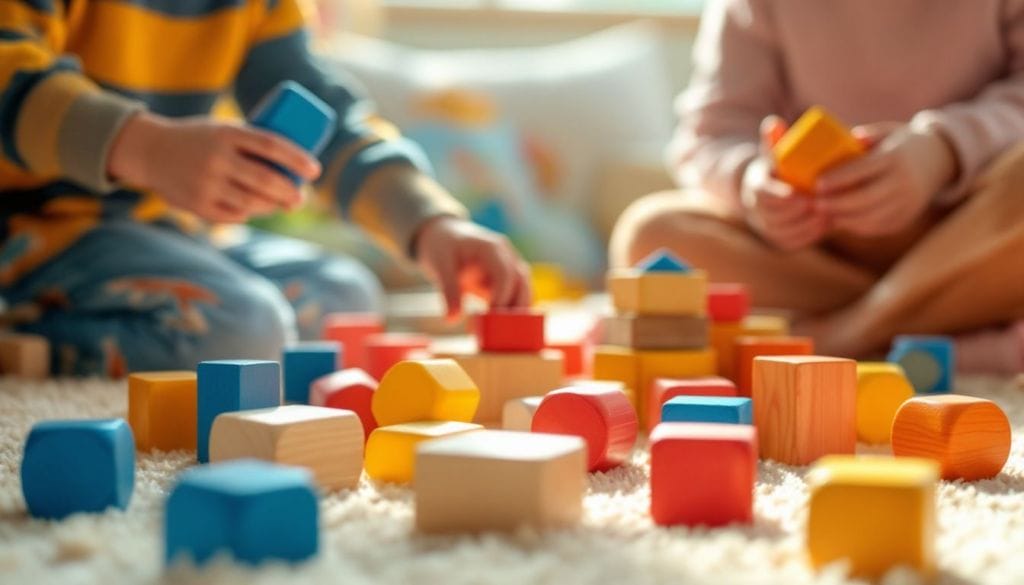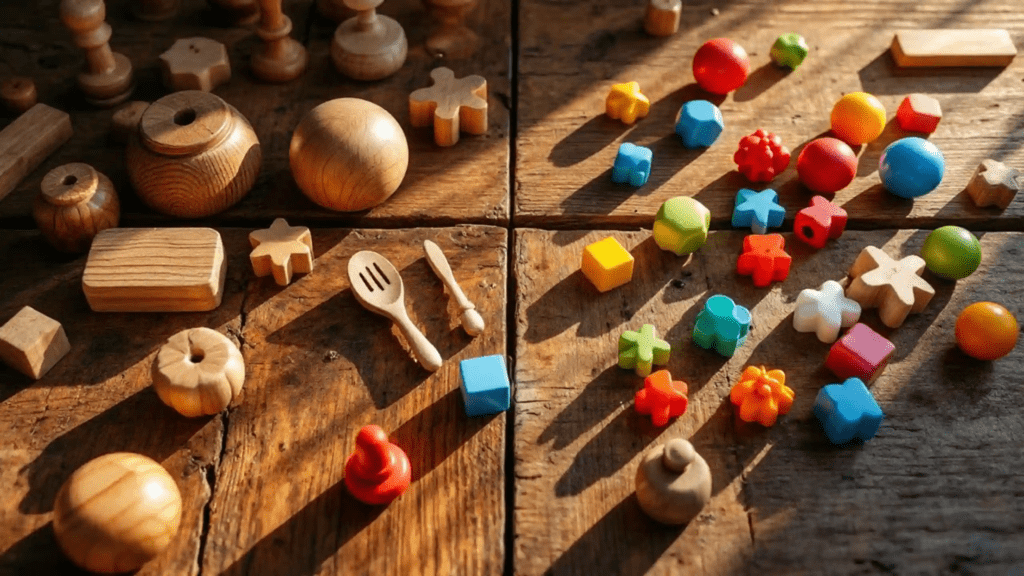Wooden blocks are a timeless toy, offering more than just entertainment for children. These simple yet versatile tools enhance multiple skills. They can promote cognitive development, improve fine motor skills, and foster creativity.
Made from natural materials, wooden blocks are environmentally friendly and safe. As children stack, sort, and build, they engage in problem-solving and critical thinking. Meanwhile, they also enjoy the sensory experience of working with wood. Discover the myriad benefits that wooden blocks can bring to early childhood development.
Key Takeaways
- Wooden blocks promote creativity and exploration through open-ended play.
- They enhance problem-solving skills and spatial awareness by manipulating shapes and structures.
- Wooden blocks support the understanding of mathematical concepts of balance and symmetry.
- They contribute to sensory development with diverse textures and weights.
- Blocks are durable and safe, ensuring long-lasting play and cognitive growth.
Why Are Wooden Blocks Considered Valuable?
Let’s focus on why educational settings prefer wooden blocks.
Unique Features of Wooden Blocks for Children’s Play
Wooden blocks offer several unique features that make them invaluable for children. As open-ended toys, they provide endless possibilities. They allow children to learn and explore creatively.
When kids manipulate these blocks, they develop hand-eye coordination and spatial awareness. The varying sizes, shapes, and colors also help them understand mathematical concepts like symmetry and balance.
Their tactile nature enhances sensory development. They offer children a chance to experience different textures and weights. This hands-on play fosters fine motor skills. When kids stack and build, they can tackle the challenge of the blocks’ weight.
Besides, wooden blocks are durable and safe, ensuring they withstand active play. Overall, these blocks are more than toys—they’re essential learning tools.
How Does Open-Ended Block Play Enhance Creativity?
Open-ended block play lets children release their creativity. Children can construct unique structures and explore limitless possibilities. This type of play encourages them to experiment with different designs. This will enhance problem-solving skills as they aim for stability and balance.
Open-ended play supports symbolic thinking. It allows kids to use blocks to represent various objects. This will expand their creative storytelling abilities. Furthermore, children who play collaboratively enhance their teamwork and communication skills.
These experiences not only foster collaboration but also contribute to cognitive development.
Why Are Wooden Blocks Effective for Spatial Awareness Development?
Wooden blocks offer opportunities to explore spatial relationships. When children experiment with different shapes and sizes, they learn how pieces fit and interact. Play supports their understanding of dimensions and enhances visual-spatial skills.
As they stack and balance, children learn to anticipate gravity and balance’s effects. Manipulating blocks hones motor skills and hand-eye coordination. These are vital for tasks like rotation and alignment.
This hands-on experience nurtures spatial reasoning. It lays the groundwork for future mathematical understanding.
What Are the Wooden Blocks Benefits?
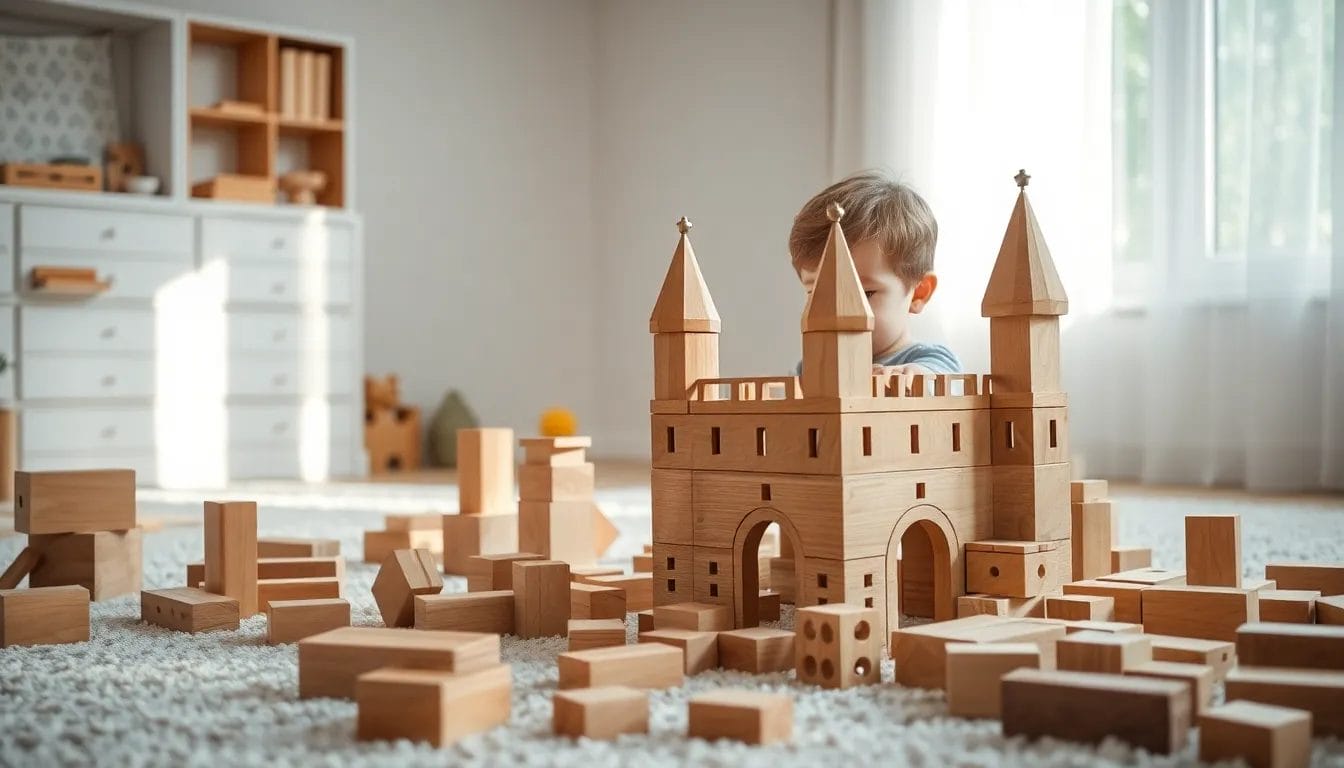
Next, we’ll discuss how blocks can contribute to a child’s learning and development.
Blocks help develop problem-solving skills. As children stack and manipulate blocks, they improve their fine motor skills and hand-eye coordination.
Collaborative play nurtures social skills, including teamwork, negotiation, and conflict resolution.
Building blocks introduce children to early math concepts like counting, shapes, and spatial awareness.
These experiences lay the groundwork for future learning in architecture and engineering. The sense of accomplishment from completing structures boosts emotional growth, too.
Fundamentally, block play is a cornerstone of holistic childhood development.
What Skills Do Children Develop Through Playing with Blocks?
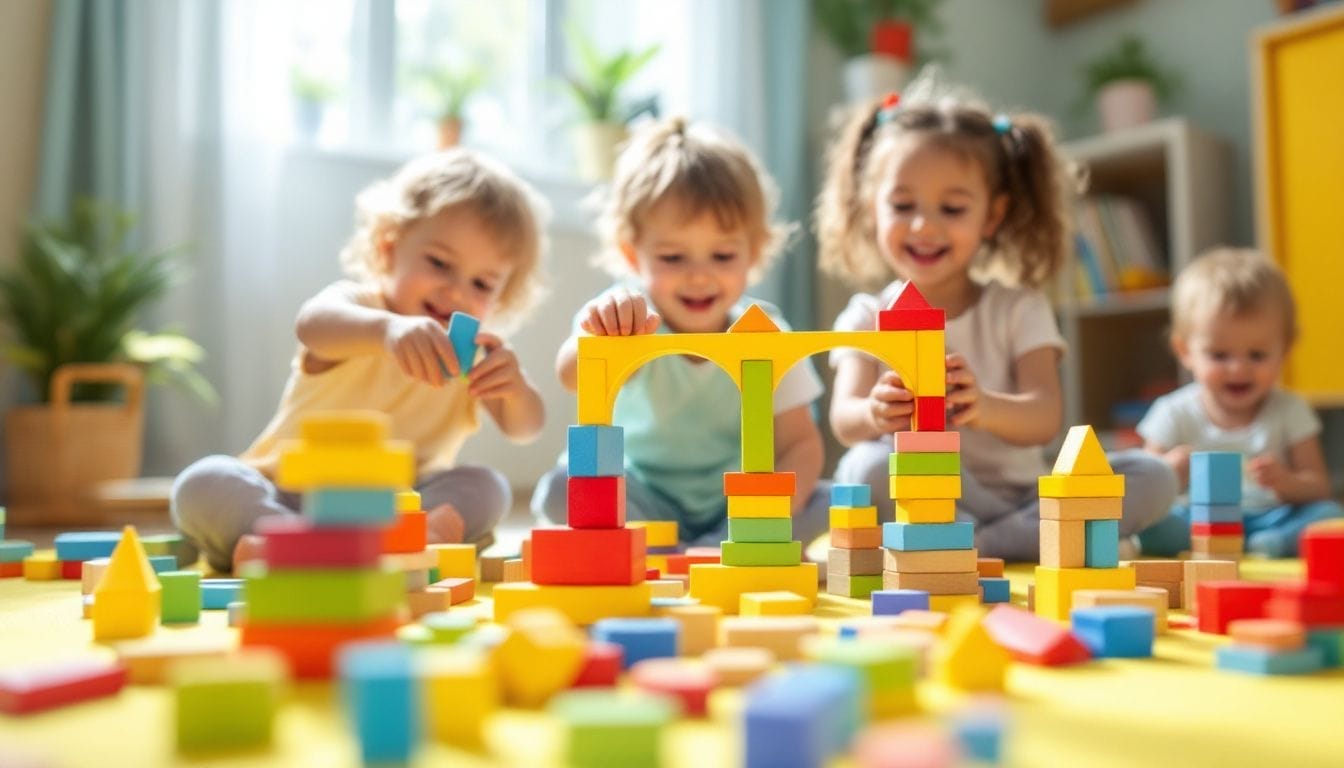
When your child plays with blocks, they’re more than having fun. They’re building important skills.
How Does Block Play Promote Early Math Skills?
Engaging in block play ignites a child’s early math skills. The blocks weave foundational concepts into the child’s imaginative activities.
When children use blocks, they naturally explore counting as they stack or line them up. This will boost their numerical understanding. Their problem-solving abilities flourish as they experiment with balance and stability. Because kids will apply mathematical reasoning to prevent structures from toppling.
Kids enhance their grasp of measurement and spatial reasoning by measuring and comparing the lengths and heights of block structures.
Building balanced structures also introduces geometric concepts. This allows kids to recognize patterns and symmetry.
What Impact Does Block Play Have on Language Development?
Block play is also essential for language development. By describing their creations, children expand their vocabulary and language abilities.
Block play supports language development by encouraging children to express ideas and stories. This will boost oral self-expression.
Through cooperative play, kids negotiate roles and share ideas. This will enhance effective verbal interactions.
Additionally, listening and responding to peers develops both verbal and non-verbal communication skills. This will foster a strong linguistic foundation in children.
How Does Block Play Foster Social and Emotional Development?
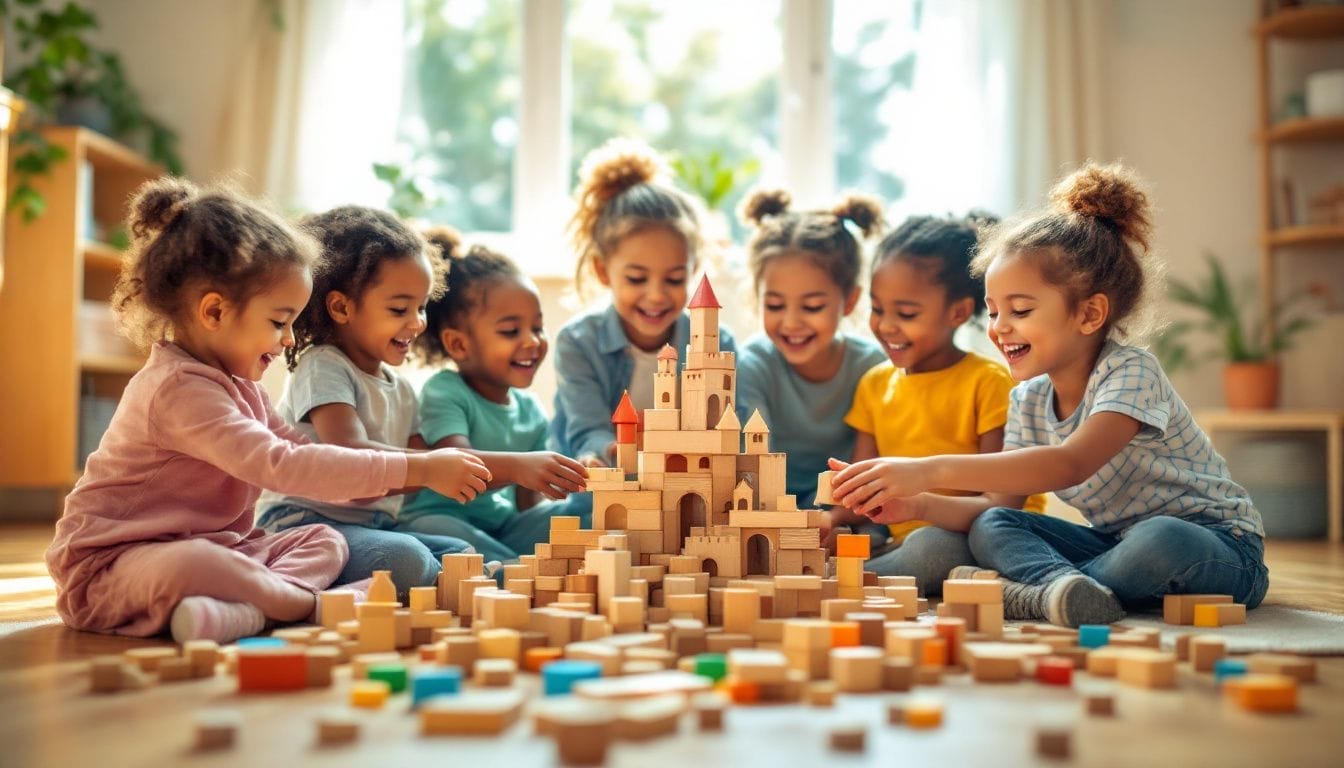
Next, let’s examine how engaging with blocks can enhance emotional skills in children.
How Does Block Play Support Social Interactions?
In cooperative play, children learn to share materials and engage in emotional growth. They practice turn-taking. This is vital for developing patience and understanding in social settings.
These interactions help them build empathy and see things from different perspectives. When challenges arise, kids work together to solve problems. This will enhance their ability to resolve conflicts peacefully.
Through these shared experiences, children form bonds and a sense of community. These pave the way for strong friendships and improved social skills.
How Does Dramatic Play Contribute to Emotional Development?
In block play, children also nurture their emotional development through dramatic play. Immersing in imaginative scenarios allows children to express their emotions and ideas creatively. Thus, they can foster self-awareness and resilience.
Successfully completing block structures instills a sense of accomplishment, boosting self-esteem.
Dramatic play using blocks provides a safe space to explore emotions. It helps kids process experiences and expand their emotional vocabulary.
What Are the Benefits of Taking Turns in Block Play?
Why is turn-taking in block play so important for children? Taking turns helps develop fundamental social skills, like cooperation and patience. Children who share resources and negotiate roles learn to work in groups.
Successful turn-taking builds social skills and boosts self-esteem. Children feel confident when they contribute effectively and receive acknowledgment from their peers.
Each turn reinforces their self-worth and strengthens their ability to regulate emotions. This will foster well-rounded social and emotional development.
What Are the Different Stages of Block Play?
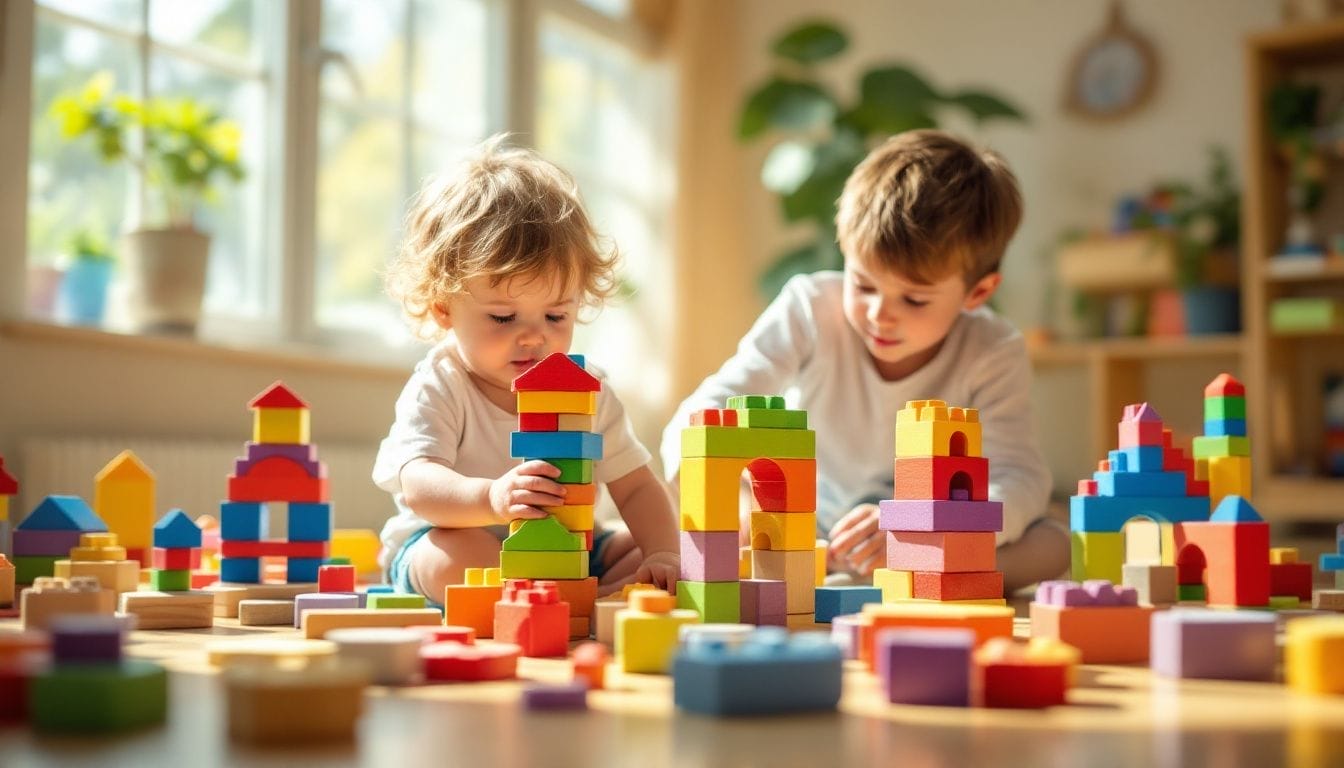
As children grow, block play evolves. It starts with simple stacking and moves toward more complex structures.
How Does Block Play Evolve as Children Grow?
Children’s development is evident in the early stages. They stack three blocks between 16 and 18 months. So they can hone their fine motor skills and hand-eye coordination.
By 18-22 months, they enthusiastically stack six blocks. They often engage in collaborative play, which boosts their social and emotional growth.
As they reach 23-26 months, lining up blocks becomes a focus. This will enhance their precision and imitation skills.
At age three, creative block play emerges. It allows children to build imaginative structures, fostering creativity and problem-solving.
This evolution supports critical thinking and encourages teamwork among children of different ages. It serves as a valuable tool for holistic development during early childhood.
What Types of Block Play Are Common in Children’s Development?
Around 16-18 months, your child may stack three blocks on each other. This activity supports their balance and timing skills.
By 18-22 months, stacking six blocks becomes a thrilling challenge. This will promote both fine and gross motor skills.
As they reach 23-26 months, your child may start lining up blocks. This will hone precision and imitation abilities.
Conclusion
Incorporating wooden blocks into playtime offers incredible benefits for your child’s development. They’ll release creativity, build problem-solving skills, and enhance spatial awareness.
These blocks don’t just support cognitive growth. They also aid in sensory development with their varied textures and weights. Plus, they encourage important math concepts like symmetry and balance.
By choosing wooden blocks, you invest in a durable, valuable tool. It helps foster both social and emotional growth.
FAQs
What Are the Benefits of Wooden Blocks?
Wooden blocks enhance cognitive skills, fine motor abilities, and social interaction. They also encourage creativity and problem-solving. In addition, they offer emotional benefits like accomplishment and reduced anxiety. Thus, wooden blocks can support holistic growth and learning.
What Are 5 Developmental Benefits of Block Play?
Block play boosts problem-solving, fine motor skills, and social skills. It enhances cognitive growth through math concepts and spatial awareness. Plus, it builds emotional resilience. It offers kids a sense of achievement and reduced anxiety.
What Do Building Blocks Teach Children?
Building blocks teach kids problem-solving, spatial awareness, and critical thinking. They enhance creativity and imagination while introducing early math concepts. Kids learn teamwork, communication, and emotional skills through hands-on exploration.

